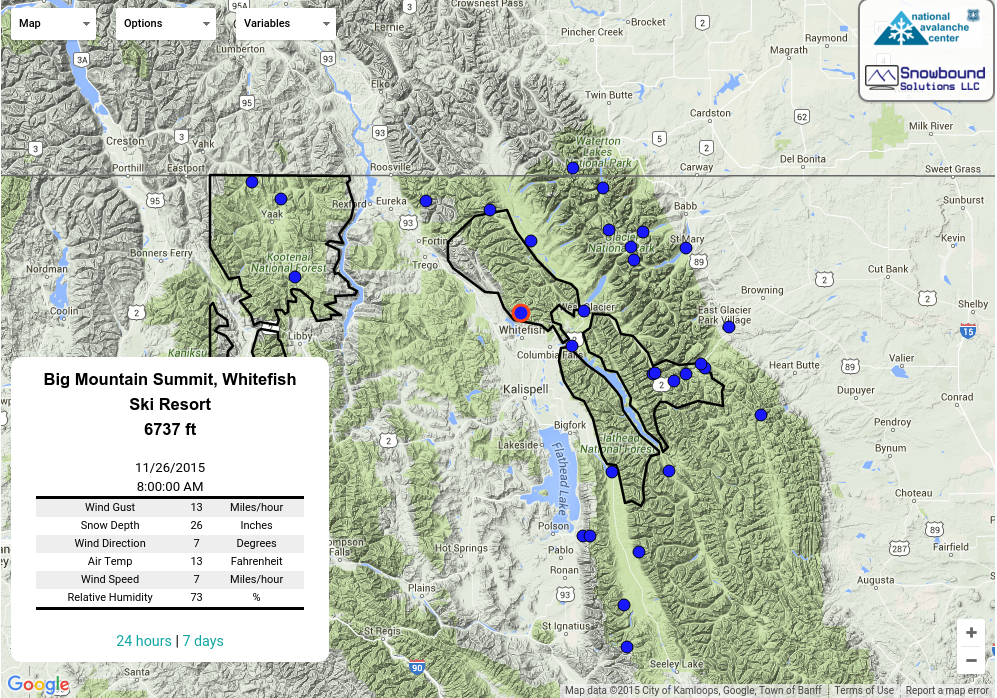| Friday | Friday Night | Saturday | |
|---|---|---|---|
| Cloud Cover: | Mostly Cloudy | Mostly Cloudy | Partly Cloudy |
| Temperatures: | 32 to 38 deg. F. | 21 to 25 deg. F. | 27 to 34 deg. F. |
| Wind Direction: | Southwest | West | Southwest |
| Wind Speed: | 21G47 | 21G53 | 10 |
| Snowfall: | 1" to 3" in. | 0 to 1" in. | 0" in. |
| Snow Line: | 6000' | 4000' | 3500' |
Whitefish Range
Swan Range
Flathead Range and Glacier National Park
How to read the forecast
A layered snowpack exists at middle and upper elevations, and thus so does the potential for slab avalanches. Be aware of changing conditions and stay alert on or below steep terrain with continuous snow cover. Recent avalanches, shooting cracks in wind drifts, and wet snow are obvious signs of danger. Always carry rescue gear when avalanche terrain has enough snow to ride. Early season obstacles increase the consequences should you get caught in a slide.

No Rating
?
Above 6500 ft.
No Rating
?
5000-6500 ft.
No Rating
?
3500-5000 ft.
-
Type ?
Changing conditions may not amount to a specific avalanche hazard, but be aware of the possible exceptions. A quick shot of snow and wind Friday afternoon may increase the risk of small wind slabs in leeward, alpine terrain through Saturday. High pressure will strengthen and keep temperatures above freezing through at least mid-week. After several days and nights of warming, wet avalanche conditions may develop. Wet surface snow could create spring-like avalanche problems on very steep slopes. If water saturates the snowpack above the crust buried mid-pack, be wary of collapses or cracks shooting through wet snow. Wet snow avalanches can be an overhead hazard as you hike to reach snow covered slopes.
The key features of the early season snowpack are a crust covered by weaker, faceted snow and a hard slab above. This structure is generally found above 5,000 feet and appears to be gaining strength. It produced large avalanches just east of the Divide on October 26th, shooting cracks in the Flathead Range on the 27th, and propagating test results near Marias Pass on the 28th. Since then, warm temperatures have promoted rounding of the facets and thus increasing stability.
A fast moving system will blow a few inches of snow through the higher peaks this afternoon creating the potential for small, dense wind slabs. A new hard crust may cover the surface thanks to freezing rain Friday, and freezing overnight temperatures Friday and Saturday. Warm air, clear skies, and calm winds will develop Saturday and remain in place under a ridge of high pressure throughout the early part of next week. As loose surface snow becomes wet, the threat of wet sluffs will rise on very steep terrain – especially where the snowpack is thinnest. Temperatures look above freezing at all elevations Monday, Tuesday, and Wednesday nights. After prolonged warming, melt-water may begin to trickle through the snowpack. If water pools in weak snow above the mid-October crust, wet slab avalanches would be increasingly concerning.
As always, monitor conditions and look for obvious signs of instability. Our snowpack tracker is a great way to stay abreast of how the weather is changing the snow.
FAC staff will monitor conditions through the fall and post updates as conditions warrant. We anticipate daily forecasts and full operations to begin in December. Your observations would be very helpful in the meantime.
Now is the time to tune up your avalanche knowledge. The 2020 Northern Rockies Snow and Avalanche Workshop will be held virtually from Nov. 12-14. The details are here and registration is open! Stay tuned for our upcoming avalanche class schedule later this fall.
A quick-moving low will bring a little snow and rain, colder temps, and strong winds today. It should clear out by tonight and a ridge will apmplify over our region through the weekend. Warm temps stick around through at least the first half of next week with no re-freeze likely until Thursday. Low pressure over Canada may strengthen and move south by next weekend.
This forecast applies only to backcountry areas outside established ski area boundaries. The forecast describes general avalanche conditions and local variations always occur. This forecast expires at midnight on the posted day unless otherwise noted. The information in this forecast is provided by the USDA Forest Service who is solely responsible for its content.










